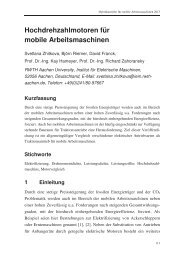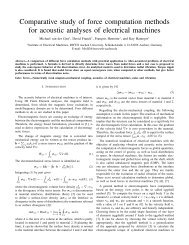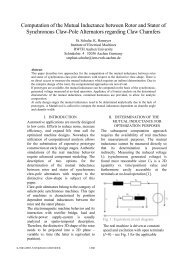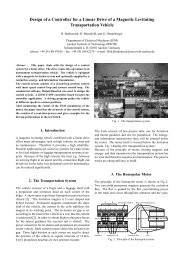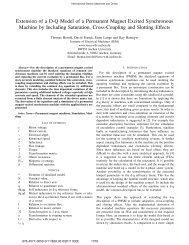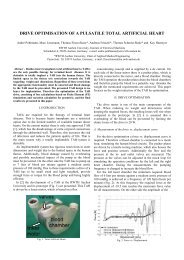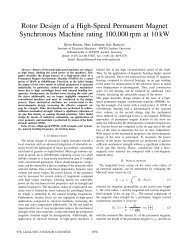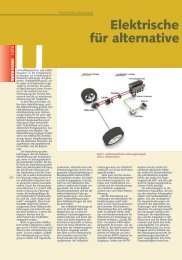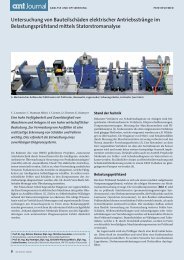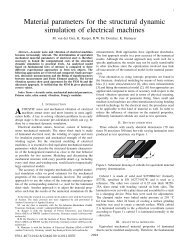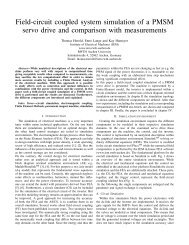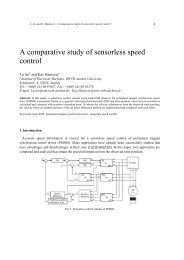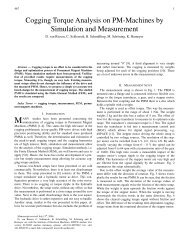Simulation of a High Voltage System in a Hybrid Electrical Vehicle
Simulation of a High Voltage System in a Hybrid Electrical Vehicle
Simulation of a High Voltage System in a Hybrid Electrical Vehicle
Create successful ePaper yourself
Turn your PDF publications into a flip-book with our unique Google optimized e-Paper software.
Fig. 12. Speed control <strong>of</strong> the PMSM.<br />
1) S<strong>in</strong>gle <strong>in</strong>sulation fault <strong>in</strong> the HV-system<br />
Due to the fact, that the HV-system is built with two<br />
separated cables electrically <strong>in</strong>sulated from the car<br />
chassis, a s<strong>in</strong>gle <strong>in</strong>sulation error does not cause a<br />
breakdown <strong>of</strong> the DC-l<strong>in</strong>k circuit. In Figure 15 the<br />
fault case occurs at 0.15 seconds. The former<br />
symmetric potentials <strong>of</strong> HV+ and HV- displace <strong>in</strong><br />
positive direction. It can be seen that the DC-l<strong>in</strong>k<br />
voltage rema<strong>in</strong>s constant. So a s<strong>in</strong>gle <strong>in</strong>sulation fault is<br />
not critical for stable operation <strong>of</strong> the HV-system<br />
(<strong>in</strong>sulated grid). The problem is that now HV- potential<br />
is connected to the car chassis and to 12V- potential.<br />
For safety issues the s<strong>in</strong>gle <strong>in</strong>sulation fault is critical<br />
and has to be detected.<br />
2) Short circuit fault <strong>in</strong> DC-l<strong>in</strong>k circuit<br />
Switch<strong>in</strong>g errors <strong>in</strong> power electronics or wrong<br />
ma<strong>in</strong>tenance can lead to short circuit faults <strong>in</strong> the HVsystem.<br />
In Figure 16 the DC-l<strong>in</strong>k is short circuited at<br />
0.15 seconds. The voltage decreases immediately and a<br />
high short circuit current occurs. Due to π-element<br />
cable model<strong>in</strong>g, small oscillations can be regarded. The<br />
complete vehicle electrical system simulation can<br />
monitor currents and voltages on all components.<br />
Herby the <strong>in</strong>fluence <strong>of</strong> the fault case to other<br />
components <strong>of</strong> the electrical system can be visualized.<br />
Dimension<strong>in</strong>g <strong>of</strong> component parameters regard<strong>in</strong>g<br />
safety aspects is possible hereby.<br />
3) Contactor fault dur<strong>in</strong>g battery charg<strong>in</strong>g<br />
Open the mechanical contactors <strong>of</strong> the battery dur<strong>in</strong>g<br />
charg<strong>in</strong>g process leads to transient effects <strong>in</strong> the HVsystem<br />
s<strong>in</strong>ce too much energy is delivered to the<br />
system. Figure 17 presents DC-l<strong>in</strong>k voltage and<br />
Fig. 13. Active rectify<strong>in</strong>g control.<br />
319<br />
Fig. 14. Control <strong>of</strong> the bidirectional DC-DC converter.<br />
charg<strong>in</strong>g current dur<strong>in</strong>g fault operation. The current<br />
decl<strong>in</strong>es under strong oscillation to zero. The voltage<br />
oscillates and returns to the nom<strong>in</strong>al value. The<br />
transient process is ma<strong>in</strong>ly <strong>in</strong>fluenced by parameters <strong>of</strong><br />
the π-element cable model and the battery model itself.<br />
Here, both mechanical contactors open simultaneously.<br />
A s<strong>in</strong>gle contactor fault can be considered and<br />
simulated, as well. The process <strong>of</strong> reconnection <strong>of</strong> the<br />
battery term<strong>in</strong>als dur<strong>in</strong>g operation <strong>of</strong> the HV-system is<br />
another critical case, s<strong>in</strong>ce transient reactions <strong>of</strong><br />
voltage and currents are expected.<br />
4) Influences <strong>of</strong> a HV-AC <strong>in</strong>sulation fault to the<br />
HV-DC system<br />
An <strong>in</strong>sulation fault <strong>of</strong> one <strong>of</strong> the cables connect<strong>in</strong>g the<br />
starter/generator with the power electronic circuit<br />
affects the HV-DC system. The error current can<br />
circulate via the car chassis, Y-capacitors and power<br />
electronics. Figure 18 depicts the error current<br />
measured directly beh<strong>in</strong>d the fault location. The shape<br />
<strong>of</strong> the current strongly depends on the cable<br />
parameters, the Y-capacitors and the actual switch<strong>in</strong>g<br />
condition <strong>of</strong> the power electronics. Regard<strong>in</strong>g safety<br />
and efficiency <strong>of</strong> the HV-system these currents has to<br />
be monitored. By this simulation the cross coupl<strong>in</strong>g<br />
between the different voltage levels can be analyzed.<br />
Influences to vehicle components <strong>in</strong> the different<br />
system parts are <strong>in</strong> focus <strong>of</strong> research .<br />
Fig. 15. Potentials <strong>of</strong> the DC-l<strong>in</strong>k dur<strong>in</strong>g s<strong>in</strong>gle <strong>in</strong>sulation<br />
fault.



